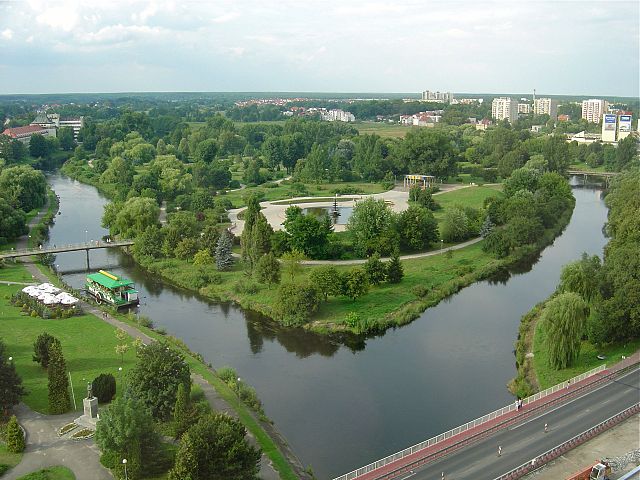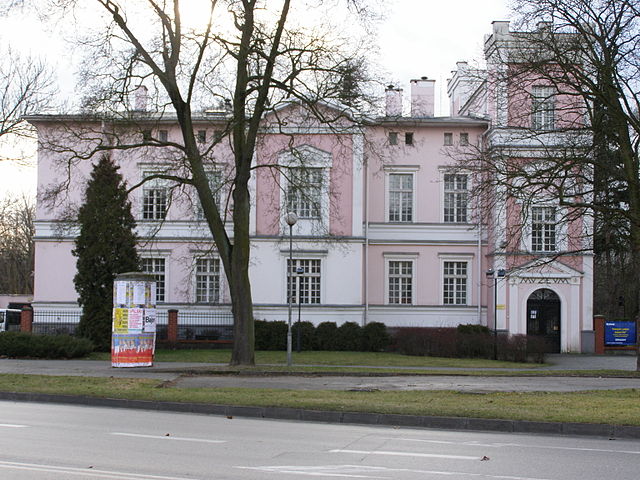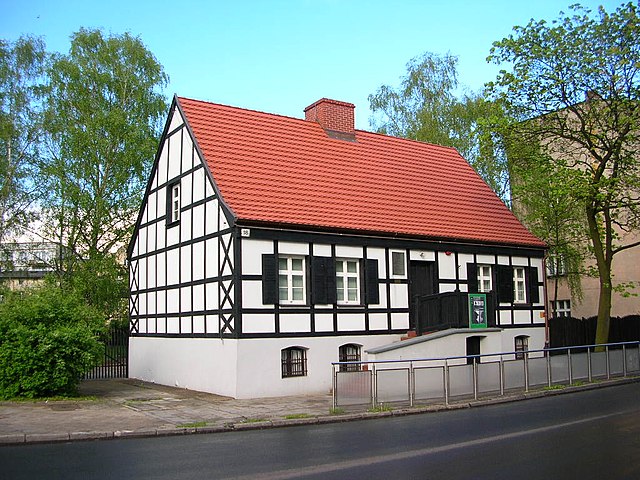Piła

The river Gwda, which flows through the center of Piła. On the island between the two river arms is a park. – Photo by: User: Wiki-observable, PL-Pila-innercity-Gromada-rodlo-Gwda-kueddow-2005 July, CC BY-SA 3.0
Distance
Population
74.550 (2010)
Location and history
The town of Piła is picturesque on the river Gwda, a right tributary to Noteć, in the northwestern part of Poland, in Wielkopolska county. From the city center to Gwda’s outlet in Noteć to the south (by the town of Ujście) there are approx. 12 km. The city is rich in greenery and parks; on the northern outskirts of the city are several lakes and a large reservoir of water. At this city, both main roads and rail lines intersect in a north-south and an east-west direction. Piła is the capital of the district of the same name. The leading industrial industries are the electronics and electrical industries as well as the printing industry. From 1975 to 1998, Piła was the administrative capital of Piła County.
Piła was originally a small fishing village located in a wooded area on the river Gwda. Presumably it was here in the 14th century. a sawmill which treated the wood from the large surrounding forests. The site was owned by the Pomeranian princes, since the Crusades, and in 1368 it was incorporated into the Polish state by Kazimierz the Great.
The Polish name of the city means “so V”; its German name (between 1772 and 1945) means “sawmill”.
The first written records of Piła as a city date from 1449 and 1456. The town probably got market town rights in 1440’erne, rights confirmed in 1513 by King Zygmunt the Old.
From the beginning of the 17th century. to the beginning of the 19th century. the city was a center for the clothing industry since the silk industry followed. The city has been hit by both disasters and war lines over time. In 1626 large parts of Piła burned. In the first half of the 18th year. the city was taken and destroyed by Swedish forces.
After Poland's first division in 1772, Piła came under Prussia. For a long time, the majority of the inhabitants were Germans. Like many other cities, the development of the rail network was an economic recovery, as was also the case when a rail link to Bydgoszcz was made in the mid-1800s. A major local business was a repair shop for railway equipment. In 1913, a large aircraft factory was built in Piła. At this factory, during World War I, approx. 100 flights a month.
By the Treaty of Versailles after World War I, Pila remained within Germany's borders because of the German population in the city. The border with the reborn Poland ran for approx. 6 km southeast of Pila.
During World War II, the city was a significant center for the German weapons industry. In 1945, Piła was transformed into a fortress and became part of the defense system “The Pomeranian Violence”. After heavy fighting, the city was captured in February 1945 by divisions of the 47th Soviet Army. As a result of the war actions, 72% of the city was destroyed (90% of the city center). The post-war reconstruction – now as part of Poland – took a long time and only happened to a greater extent from 1960’s.
The city's most famous son is Stanisław Staszic, pastor, statesman, philosopher, writer and scientist, born in Piła 1755, dead in Warsaw 1826.
The former (in the interwar period) Polish consulate building, now the district museum. – Photo by: Albertus theologian, Piła knsulat, mark as public domain, more details on Wikimedia Commons
Tourist attractions
Selected attractions:
Stanisław Kostka Church
is located in the city center, on the eastern bank of the Gwda River. It is the oldest preserved church in Piła; it was built in 1895-96 in neo-Gothic style as a gathering place for the evangelical congregation.
The church consecrated to Antonio by Padova
was built in 1929-30 by drawings by architect Hans Herkommer from the Bauhaus school. With its simplified and innovative architectural form as well as the associated monastery building with its inner courtyard with archways, the building as a whole appears as a very interesting monastic complex. The church is decorated with the largest crucifix in Europe made of wood; it is made of a single piece of wood and has a height of 7 m.
Church of the Holy Family
(ul. Jana Bosko 1) is a three-ship neo-baroque building erected in the years 1912-15. The interior of the building features barrel vaults adorned with baroque-style ceiling paintings that create scenes from the life of the sacred family. Two towers are erected above the entrance portal, crowned with tower helmets with lanterns.
district Museum
(ul. Browarna 7) has the task of collecting historical artefacts from the city and the surrounding area and exhibiting them. The permanent exhibition includes interiors from civilian homes from the first half of the 17th to the first half of the 20th century. The museum also has a publishing business and organizes archaeological investigations. The museum is located in an Italian villa that housed the Polish Consulate in the interwar period. (See photo above).
Stanisław Staszic’ home, current museum. – Photo by: No machine-readable author provided. bast assumed (based on copyright claims)., PL Piła Dom, CC BY-SA 3.0
Museum of Stanisław Staszic
(ul. Browarna 18) is a small modest house where the prominent statesman, politician and scientist is believed to have been born in 1755. The building was destroyed during World War II but subsequently rebuilt in its original form (half-timbered house). The museum has an exhibition with memories and testimonies of Staszic’ life and business.
The former arsenal
at ul. 1 May. The arsenal is the oldest preserved building in Piła; it was built in 1834-44 as an arsenal (armory / clothing store) for the Prussian Landwehr, which from 1815 was an integral part of the Prussian army.
Statue of Stanisław Staszic
on the river Gwda.
The locomotive discount in Piła
built 1870-74, called “Okrąglak” (The Round House).
shelters
on the city's eastern outskirts, built 1939-44.
Kulturhuset
which also includes parts of the police school; the monumental building was formerly a library, museum and theater.
police Academy
- former seat of the provincial authorities.
Almost nothing is preserved of the city's oldest buildings. There have been several devastating fires over time, and up to 1830’The houses were a large part of the housing stock built in wood. In July 1834, a fire erupted that consumed hundreds of houses.
Surrounding Area
The area is characterized by forests (locally called Lasy Trzebieskie), lakes and a large number of rivers: Noteć, Gwda, Piława, Rurzyca and others. The rivers are suitable for kayaking – not least Gwda running through Piła town.
There are marked bicycle routes and riding routes in the surrounding area.
Along with Gwda are the remains of the local section of the German line of defense: the Pomeranian Violence (Wał Pomorski / Pomeranian Wall).
On the northern edge of the city lies the Koszyce water reservoir and just north of this are several smaller lakes. Also to the northeast are a number of lakes; the largest of these: Płotki is a particularly popular excursion destination for the city's population as well as tourists from near and far.
Osiek nad Notecią (east of Piła) is the second largest open-air museum in Poland.
Accommodation
Booking.com
Piła (in Polish, English and German and with versions in a large number of other languages) – with practical information for tourists
Other Internet sites and sources
Piła (in Polish, English and German and with versions in a large number of other languages)
Translated into English by Google Translate. Spangshus.dk accept no liability for any errors or omissions in translation.
Map

Rating
Search
Most used tags
churches (205) Castles (86) Monasteries (79) Town walls (74) Lakes (71) Town halls (67) Rivers (65) Castles1 (62) Mansions (55) Museums (51) Regional museums (38) Town gates (36) Abbey churches (35) Castle ruins (30) Cathedrals (26) Forests (25) Health resorts (24) Mounds (23) Water sports (23) National parks (22)Click for all tags
Denne side er også tilgængelig på dansk. This page and contents is (c) Copyright 2018- www.spangshus.dk. Based on Inviator software by ISCA Software

